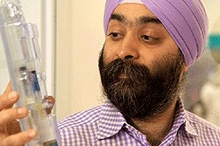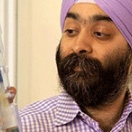

Amar Sawhney is being honored as a Champion of Change for his accomplishments as an immigrant entrepreneur and innovator.
I find myself today where I am through a series of happy accidents and some deliberate decisions. I really enjoy what I do, which is innovate in the field of medical devices and biopharmaceuticals, by using my education as a chemical engineer specializing in biomaterials. I look back today in satisfaction at having helped create several medical devices that are helping millions of patients. However, how I ended up here was far from a sure thing. In fact, being an immigrant created roadblocks early on in my career, that in a strange way helped propel me in a direction that I otherwise may never have taken, had things come easier to me.
I came to the United States in 1987 from India to pursue my graduate studies in Chemical Engineering at the University of Texas. Unlike many immigrants, I was not fleeing persecution or economic stagnation. I had a good job in hand in India, so selecting the United States for graduate studies was a deliberate choice that I made to explore a new country and get a great education. I proceeded to get my Master’s degree and looked for a job through campus placement. I applied to 30 positions and within a month was looking at 30 rejection letters, all because I lacked a green card. This was a shock to me, as I had never encountered such abject failure in the past!
The safe thing would have been to go back to India where I could surely get a job, but seeing as I liked research, I decided to double down and get my Ph.D. This turned out to be a seminal move, as my academic advisor and I invented some very cool technology. We invented methods to do super fast chemical reactions to build materials on living cells and tissues, without harming them in the least bit. This opened up some wide new horizons for the field of tissue engineering. We were approached by a California-based venture capital fund that wanted to start a company using our technology. I remember thinking then that only in the United States would someone funnel millions of dollars into the idea and dreams of a 25-year-old kid!
This and other technology I have been fortunate enough to invent with my team members went on to have major impact. We created the first sealants for lung surgery, brain surgery, and spine surgery, and other sealants for vascular and cardiac interventions. This technology is helping improve outcomes of lung and breast biopsies, decrease scar formation post-surgery, decrease radiation toxicity to healthy organs following cancer radiotherapy, create drug delivery systems for ophthalmology, treat people with abdominal aneurysms, and more. The applications seem to be endless and we are continuing to eagerly solve new challenges each day.
Early on, I realized that to most fully deploy the technology, scalability would be needed. There was no way to do all the things one wished to do, without creating some sort of a platform for entrepreneurship. My business partner and mentor, Fred Khosravi, and I decided to form Incept, an organization that would enable entrepreneurship. This was not the typical incubator. We felt that money and space were commodities, while what entrepreneurs really needed was “intellectual capital.” This sometimes meant technology and sometimes meant business expertise. We have since worked with several bright and hardworking colleagues, and now Incept has created more than a dozen companies and continues to launch at least one new company every year. Incept companies tackle challenges from sales and marketing analytics, to devices that filter blood clots during cardiac stenting, to heart valves that can be replaced without open surgery.
More importantly, we have ended up creating a community of people that include other entrepreneurs, employees, physicians, and service providers who we love working with and who share our values. We subscribe to a value system that places solving significant medical needs at the apex, working with good people next, and finally hopes to realize economic value too. We are careful not to ever invert this value system, which could corrupt our actions.
I feel humbled and privileged to have the opportunity to do what I do. I realize that nowhere else in the world would I have been able to launch into an entrepreneurial career, the way that I did, except in the United States.
Amar Sawhney is President and CEO of Ocular Therapeutix.


